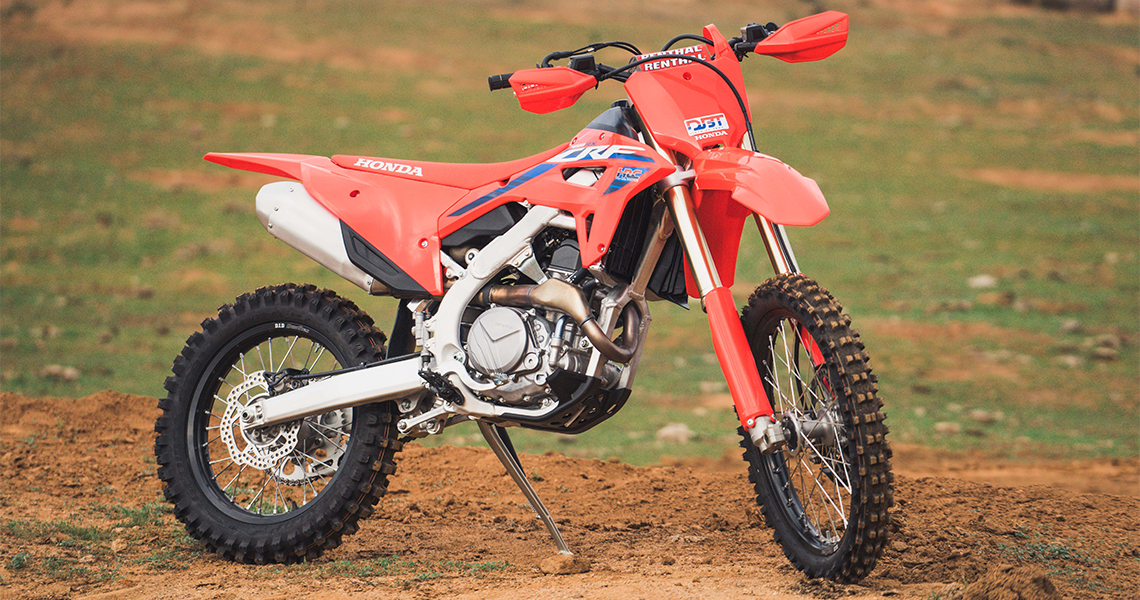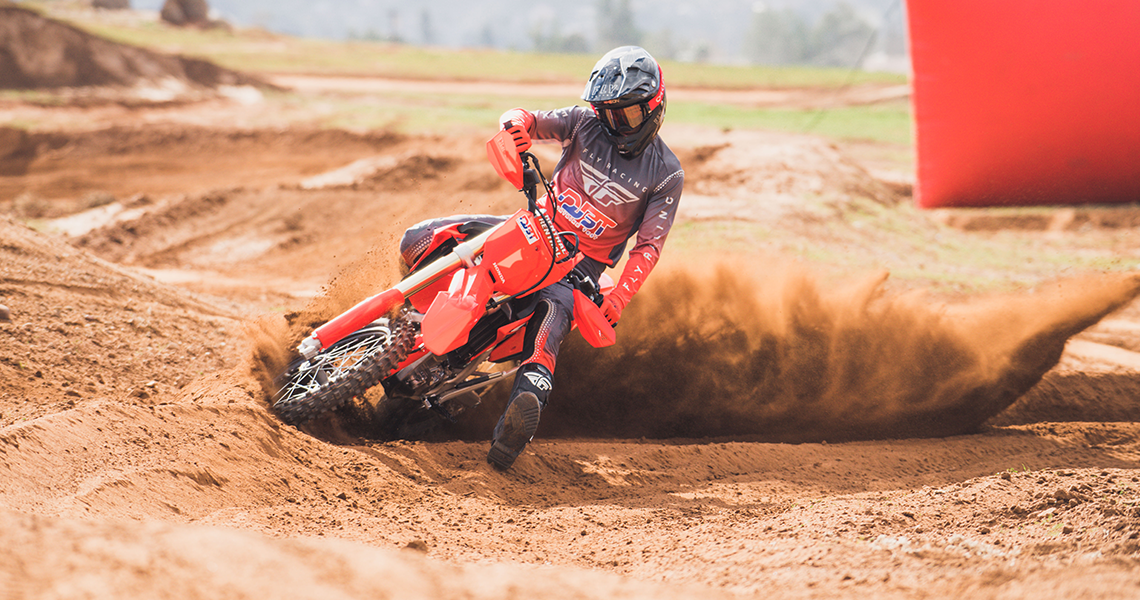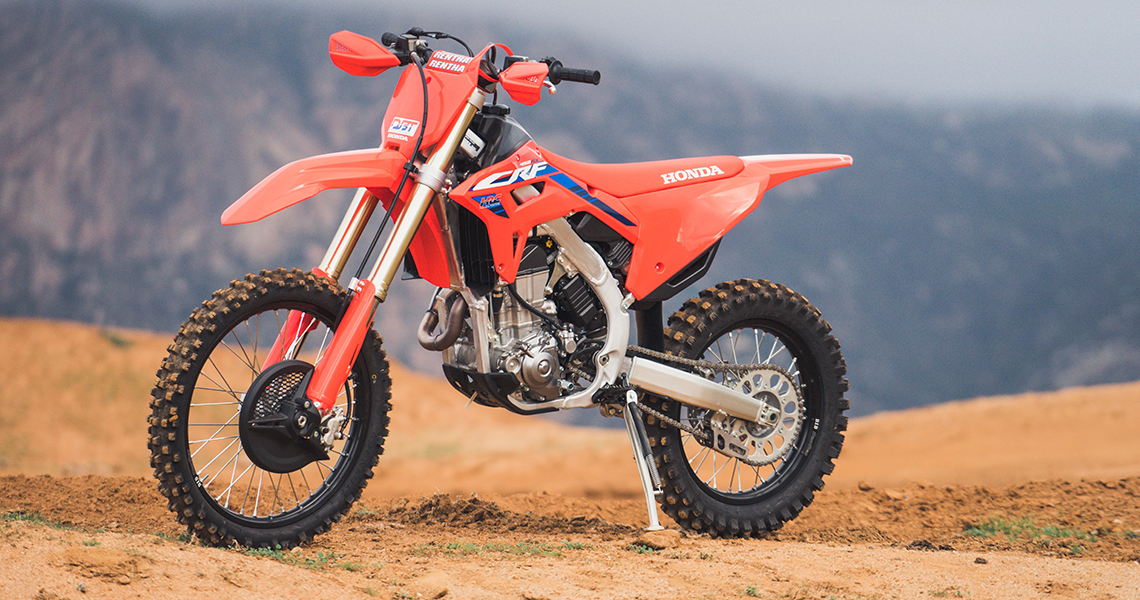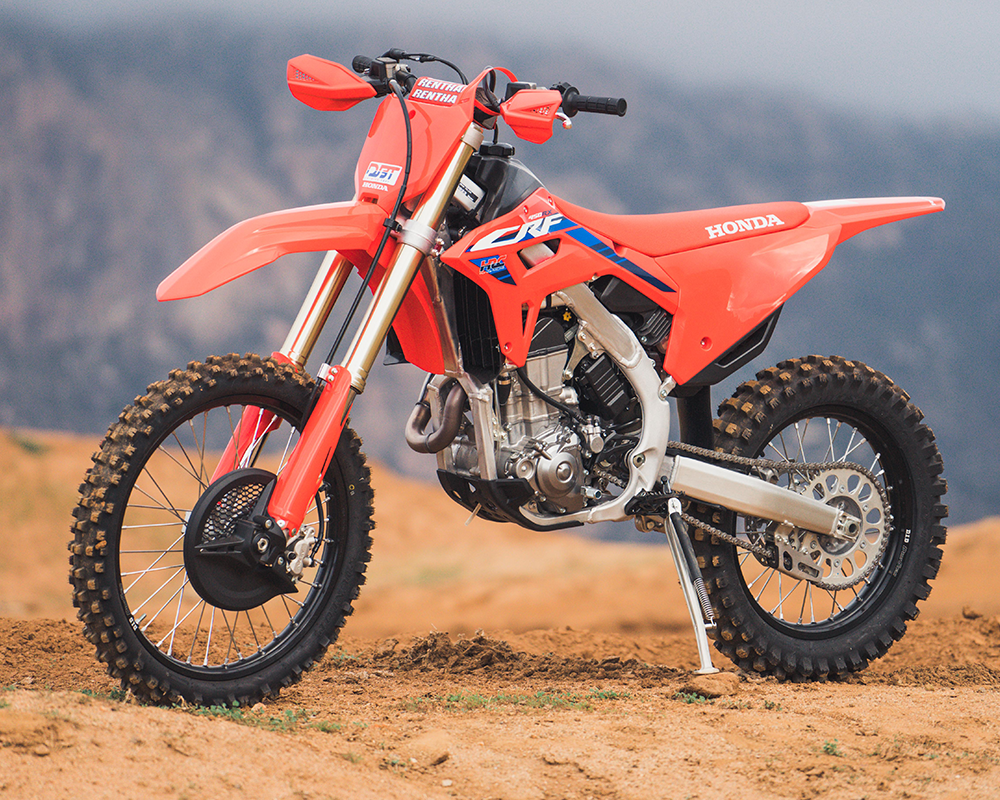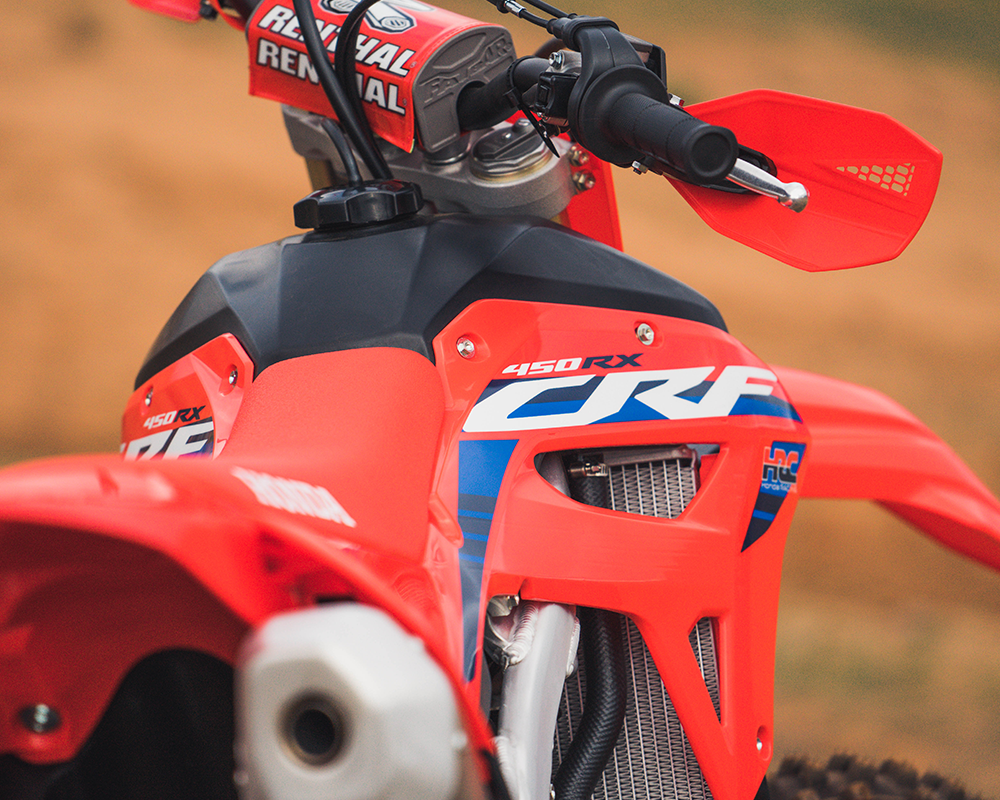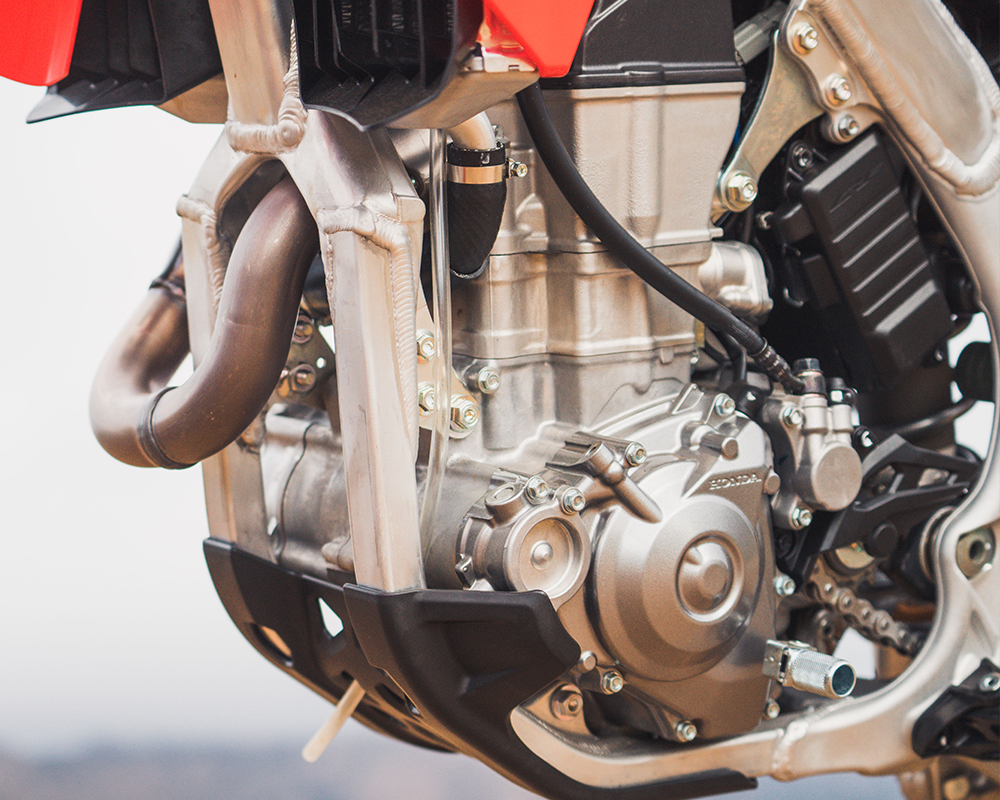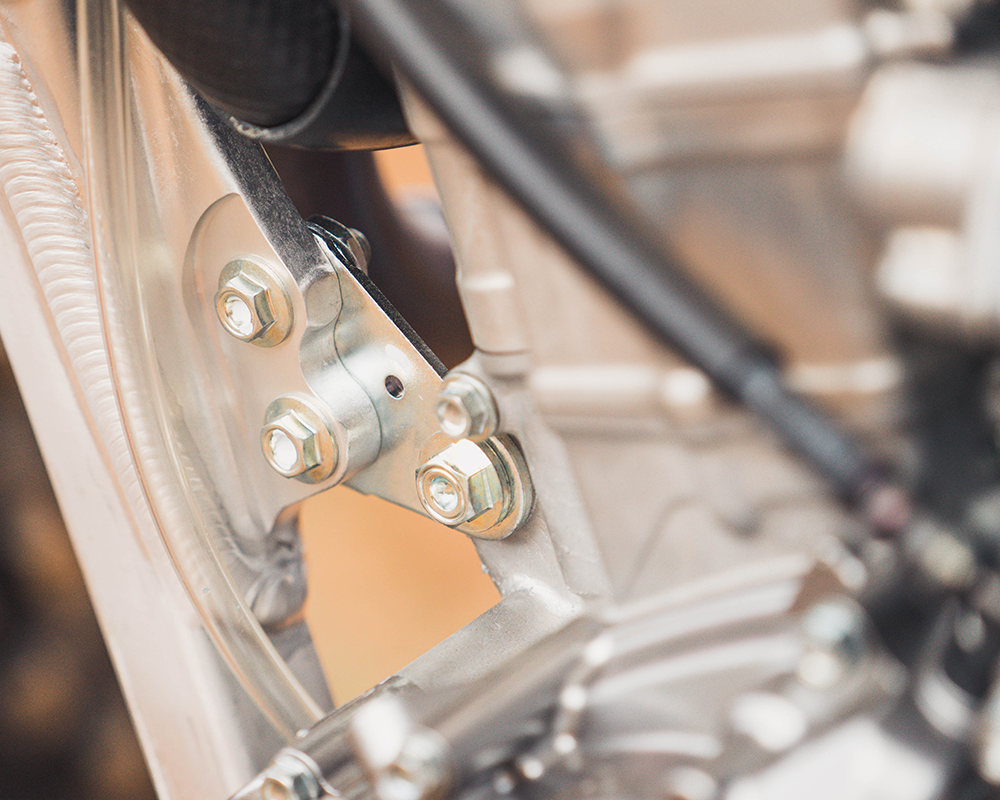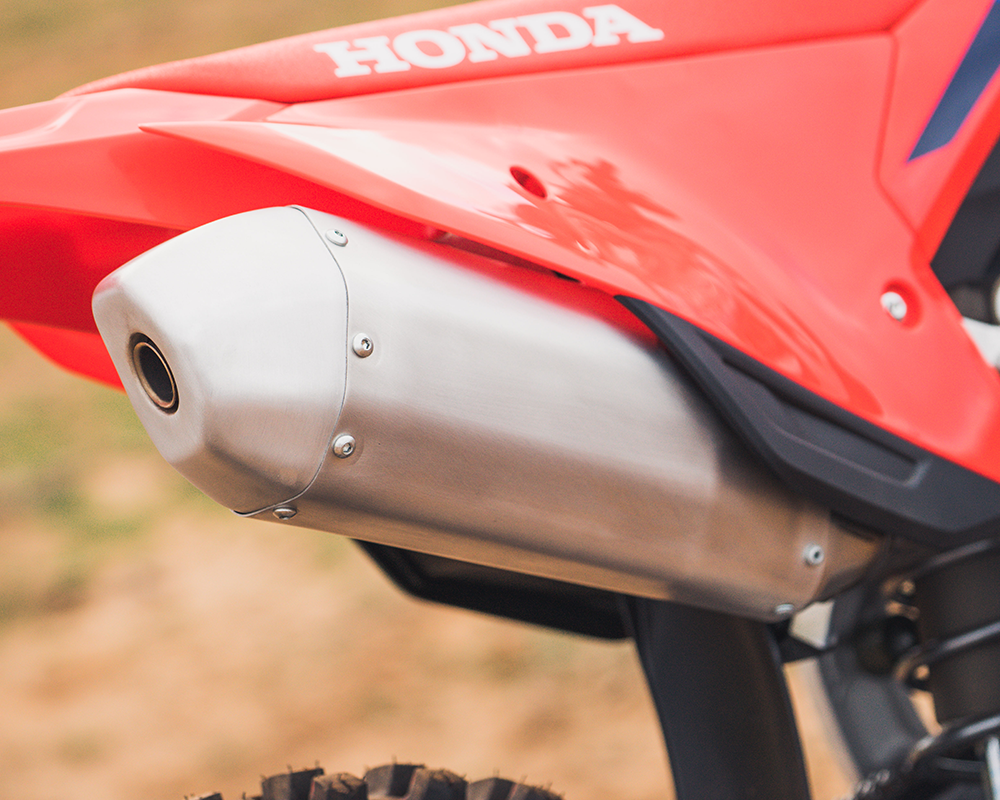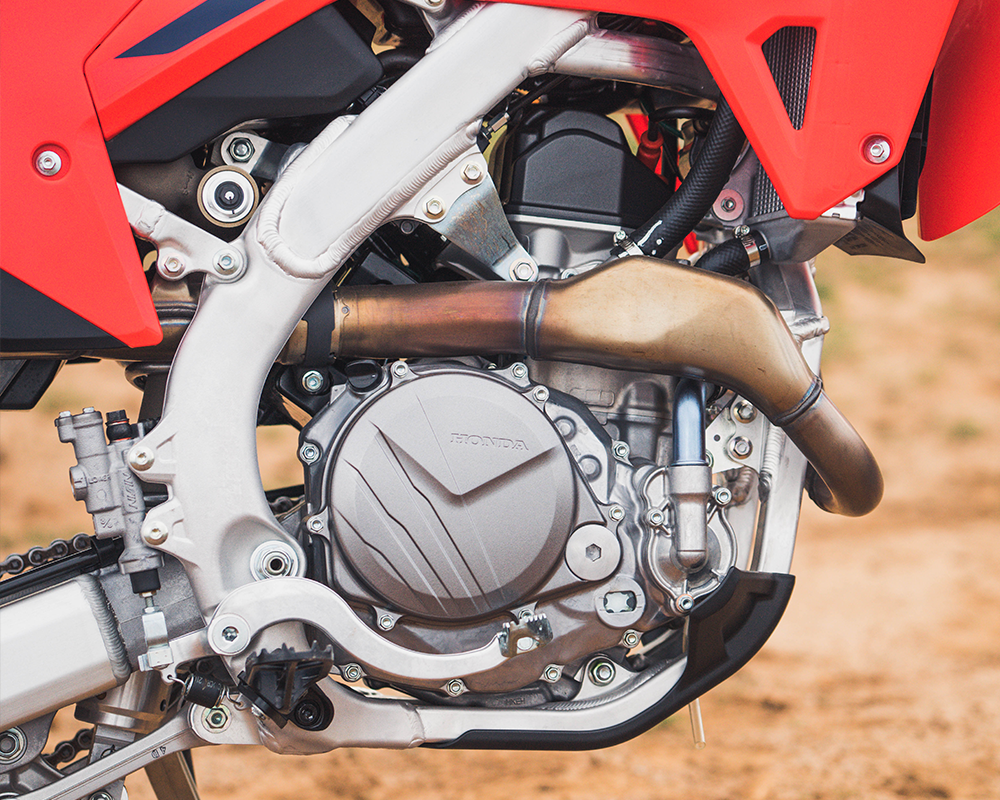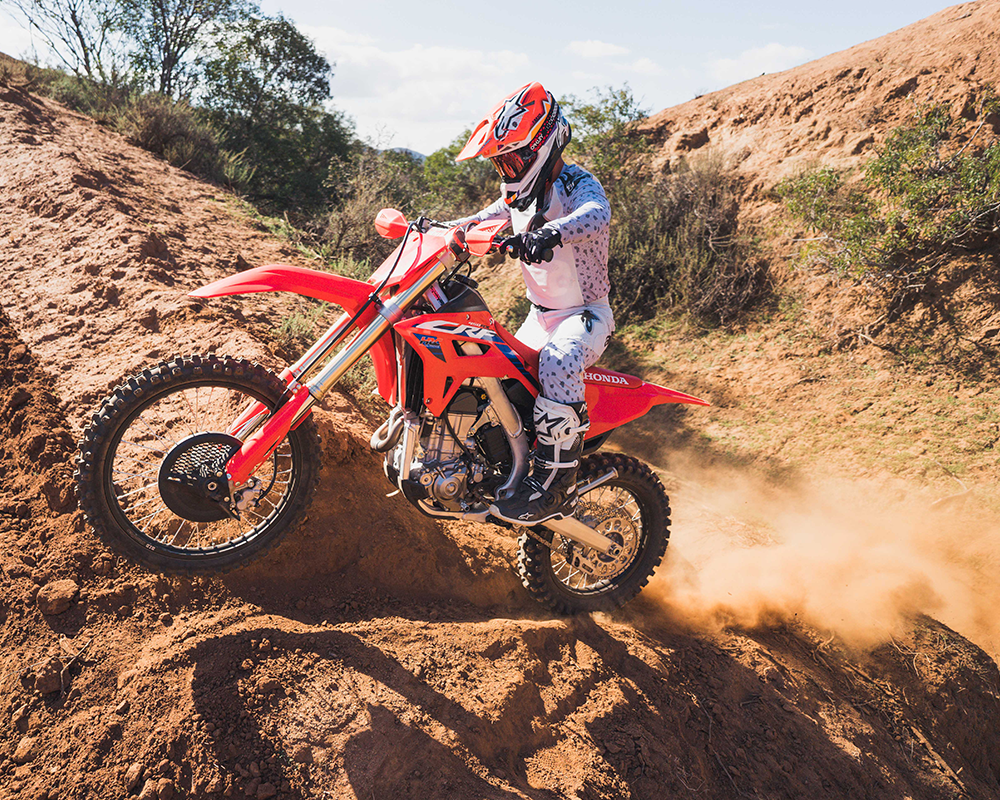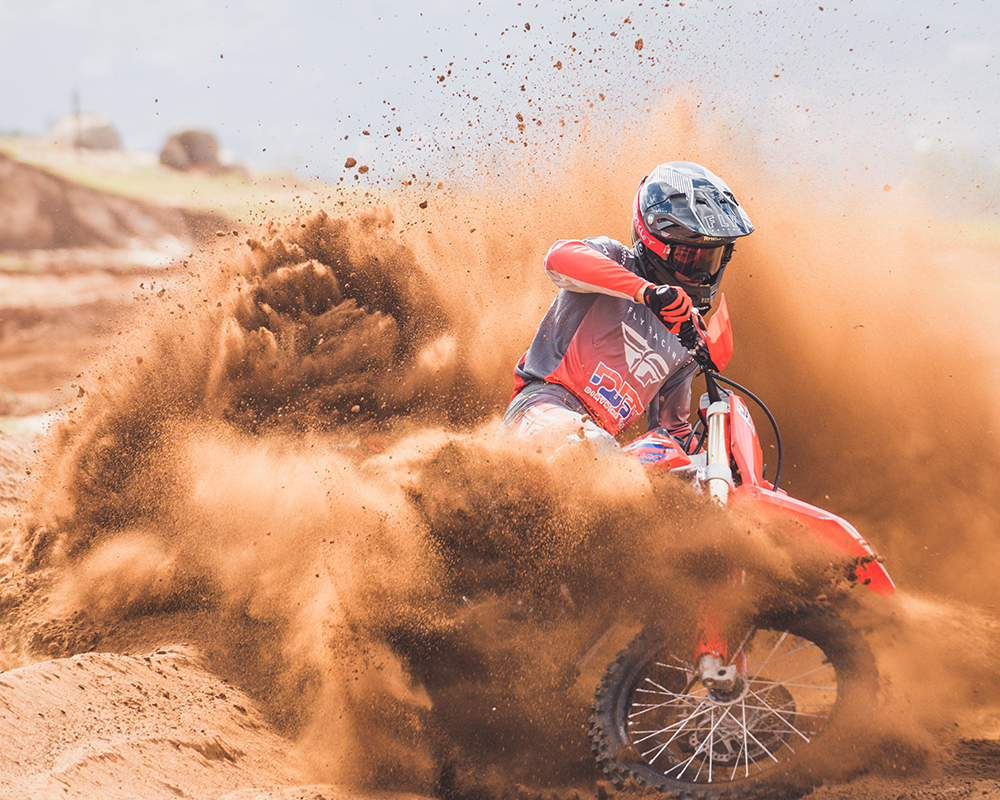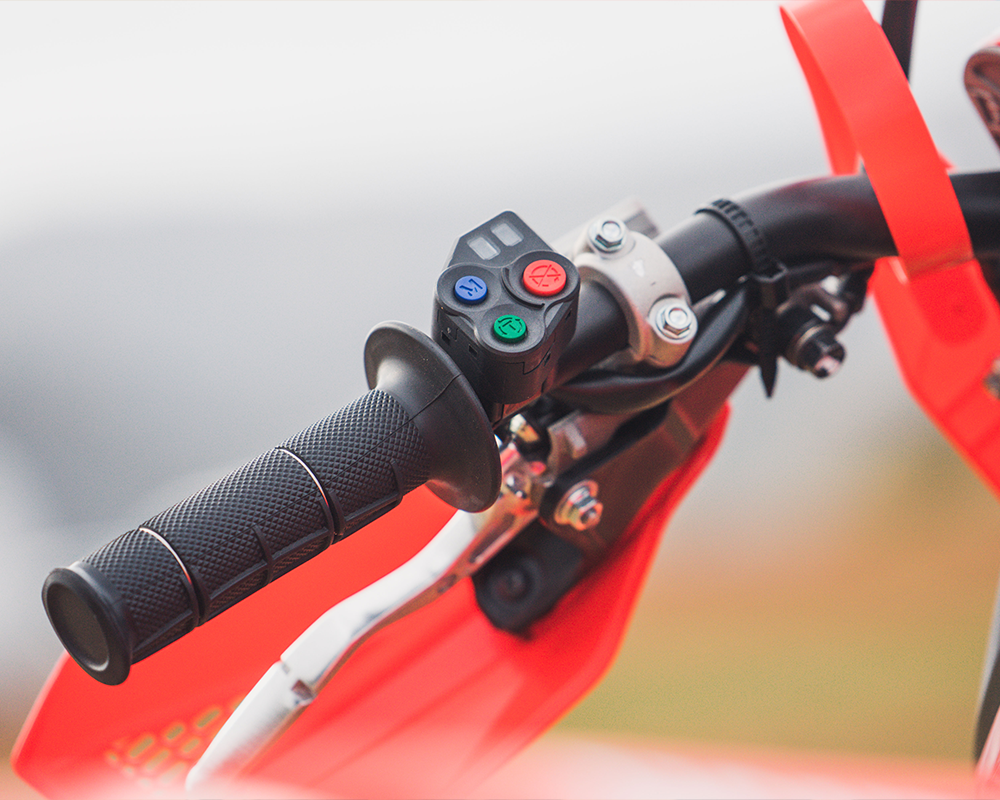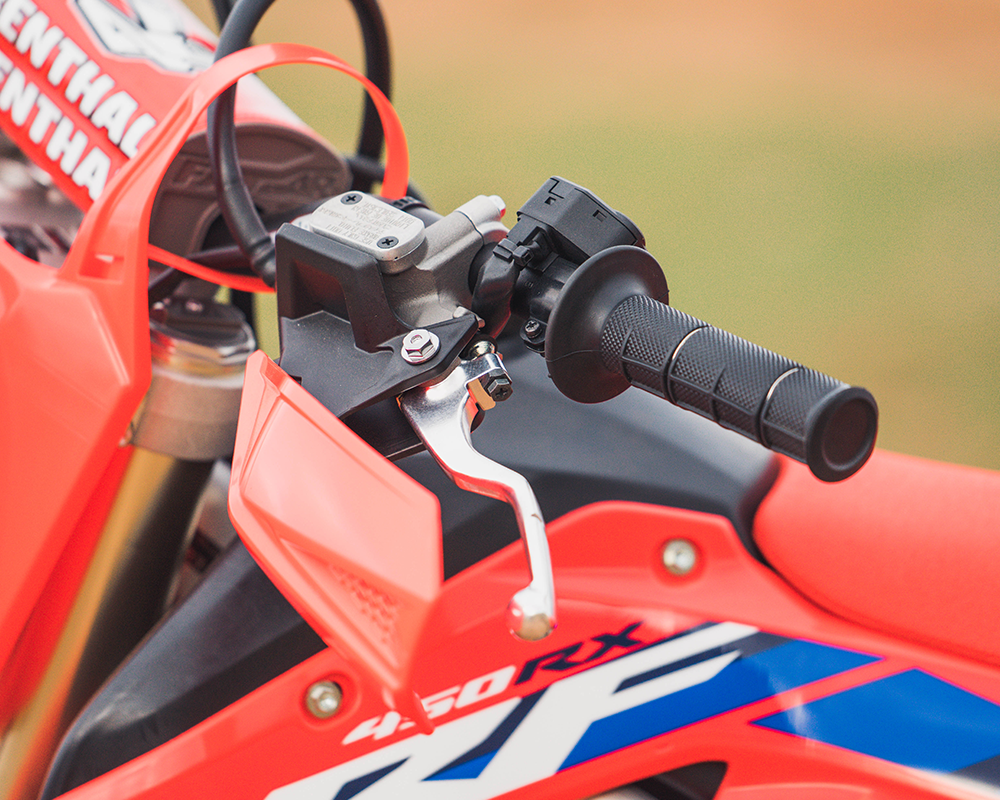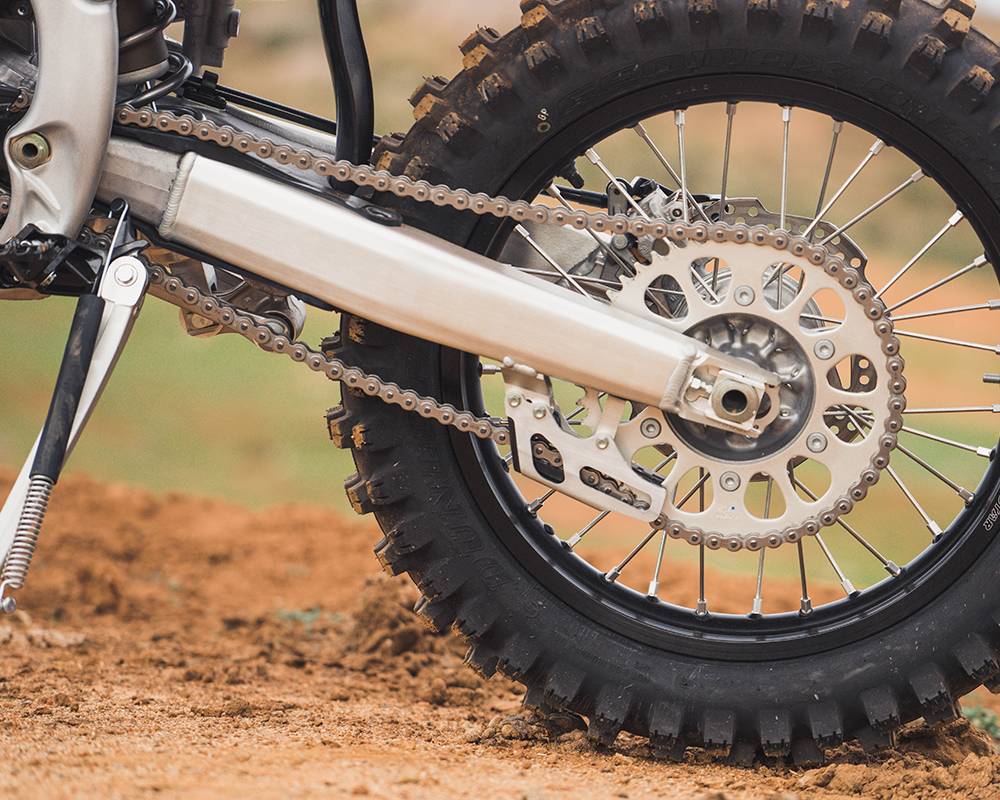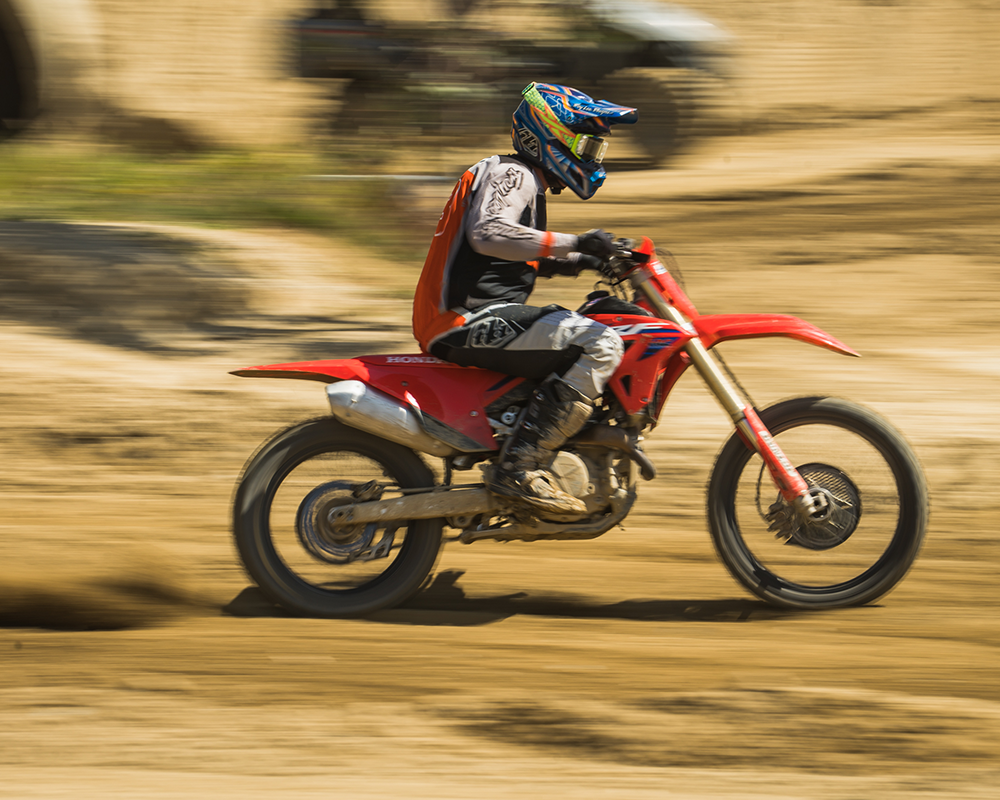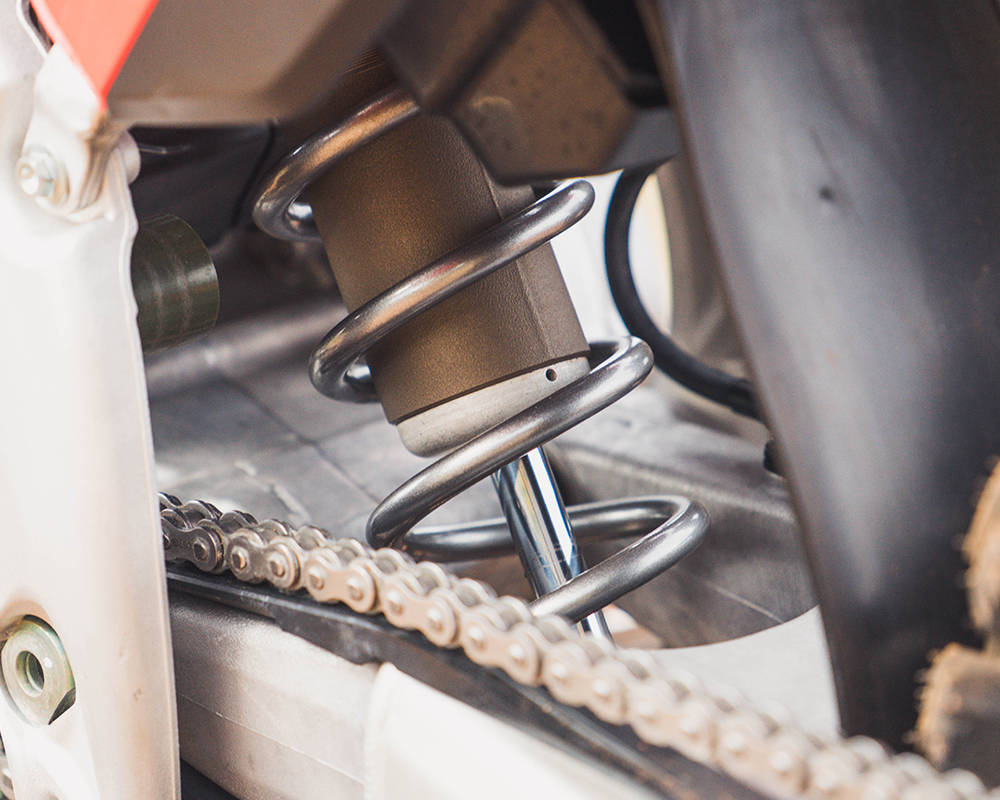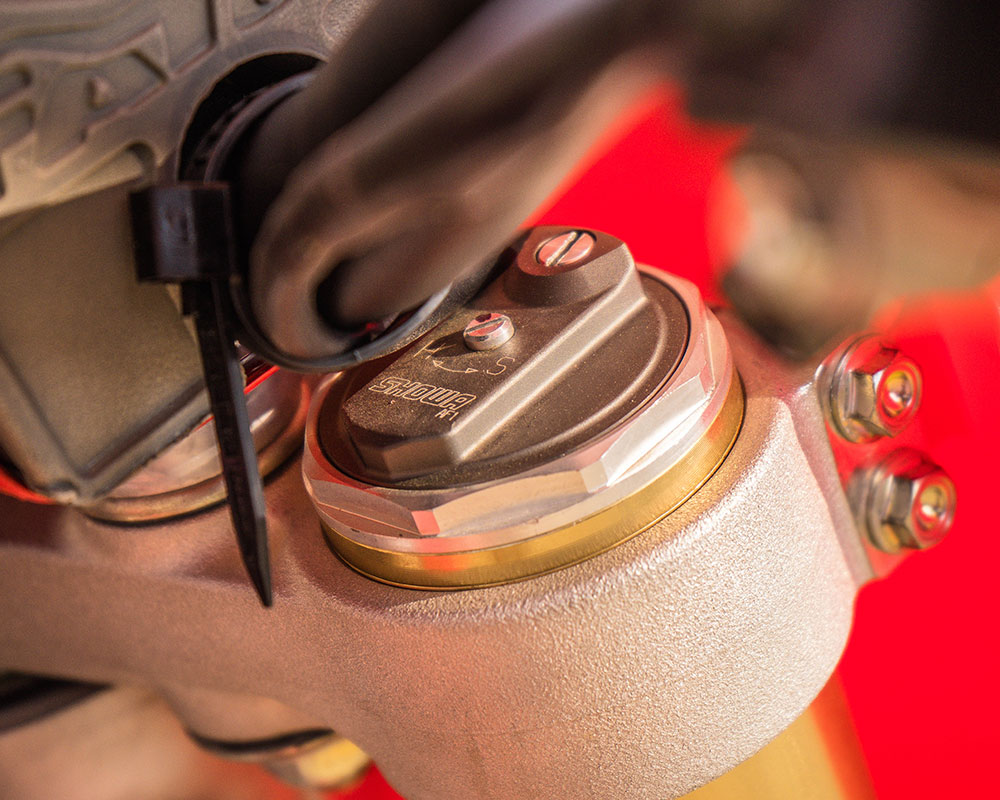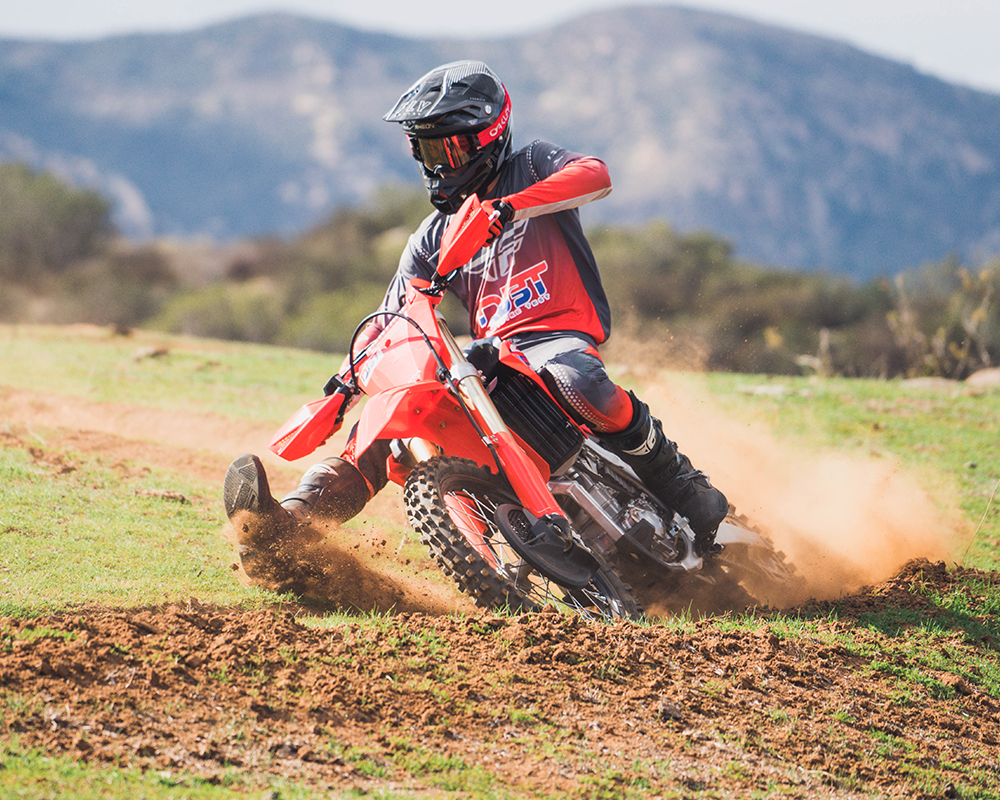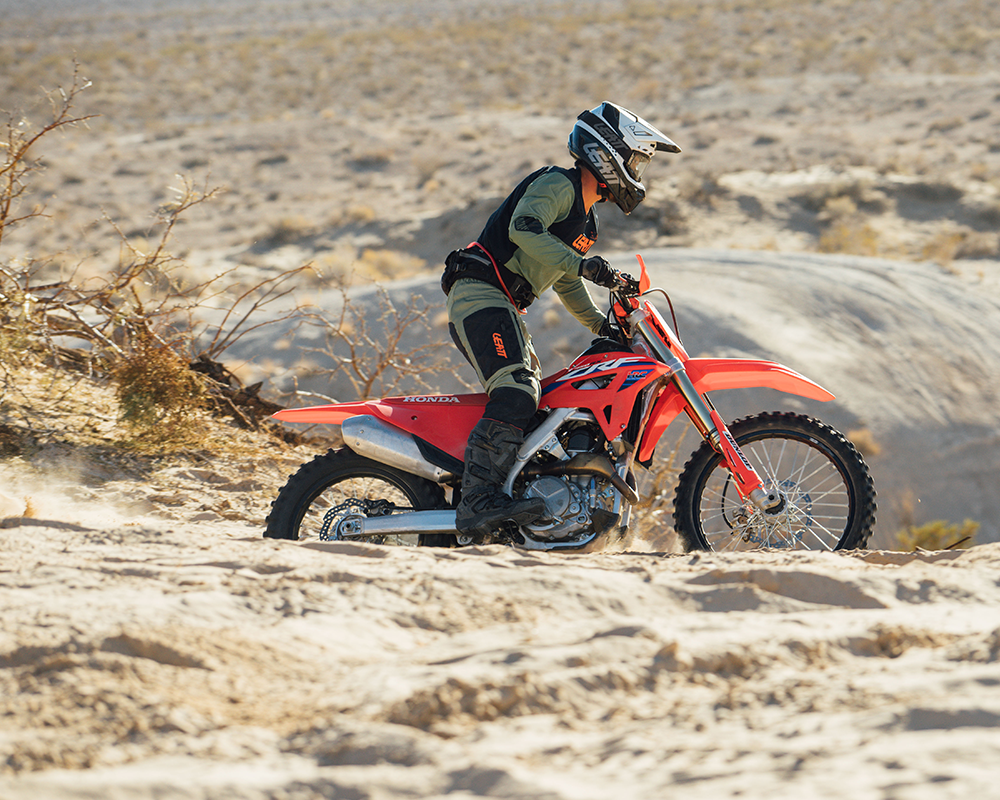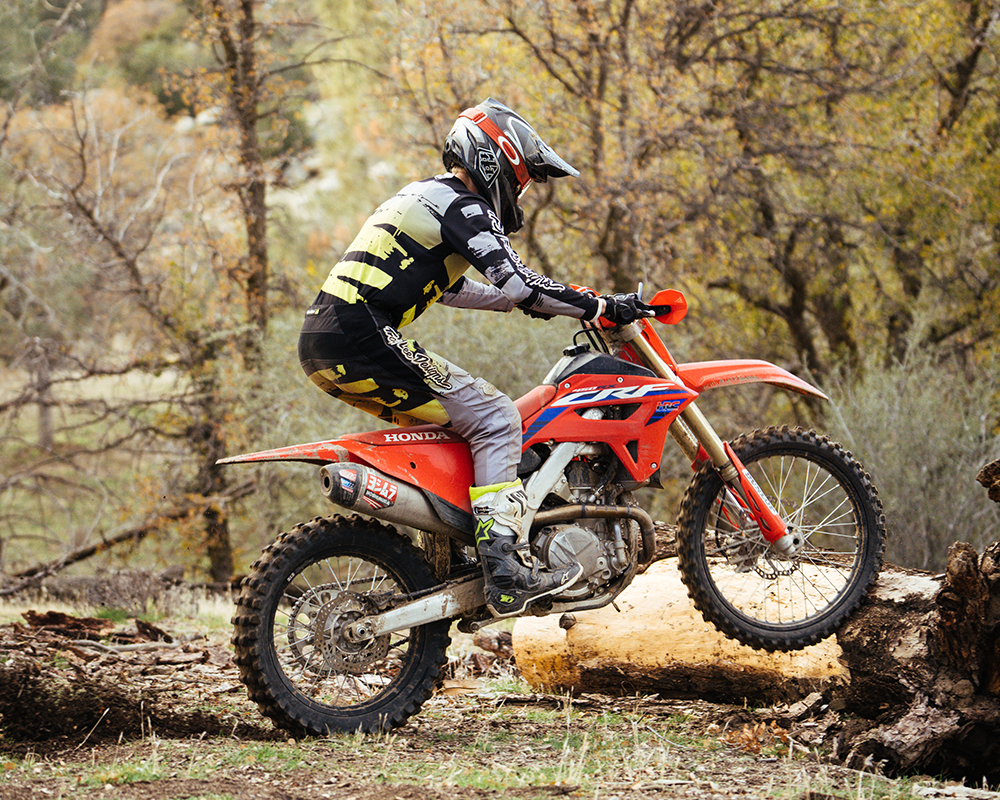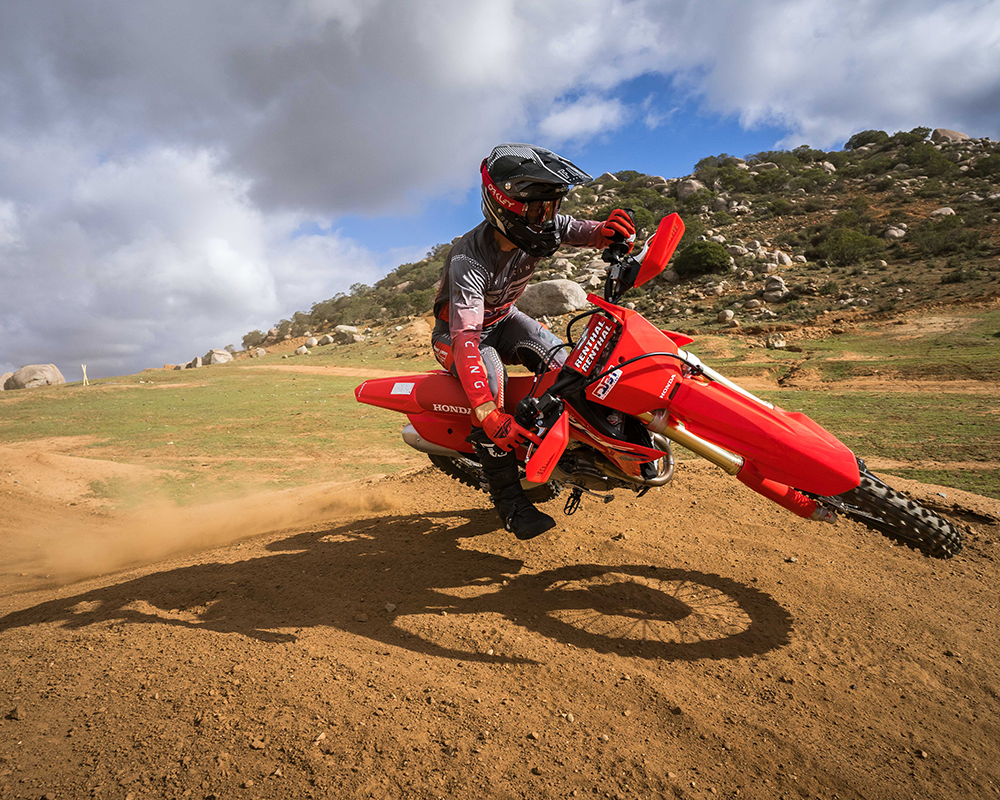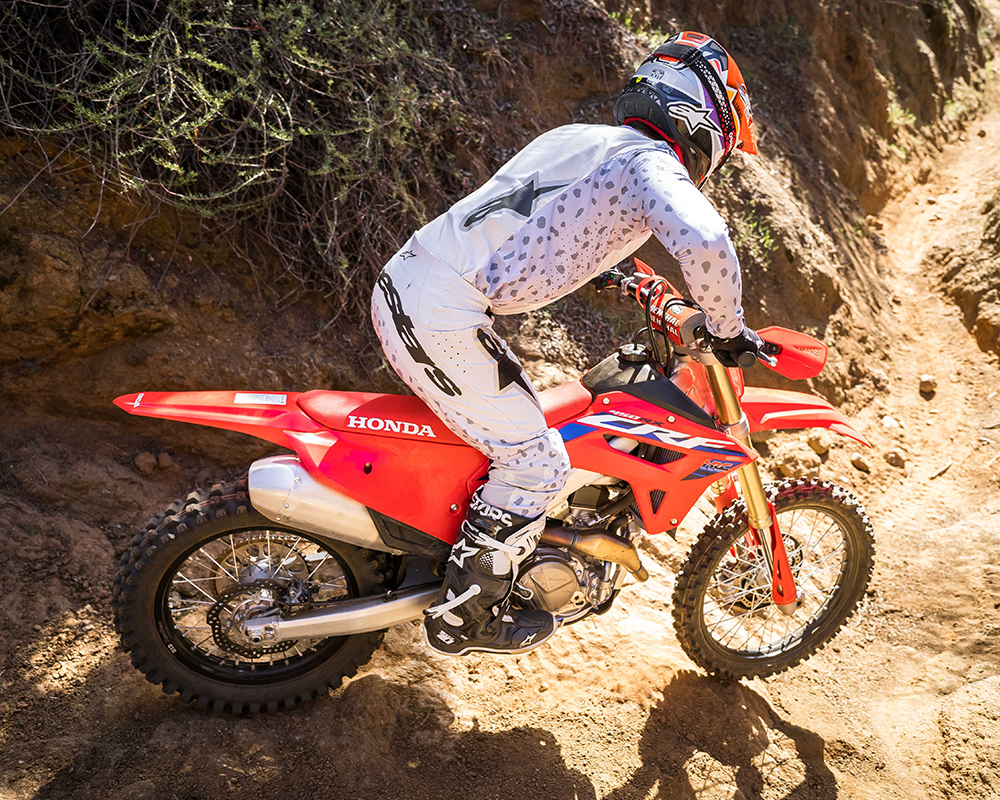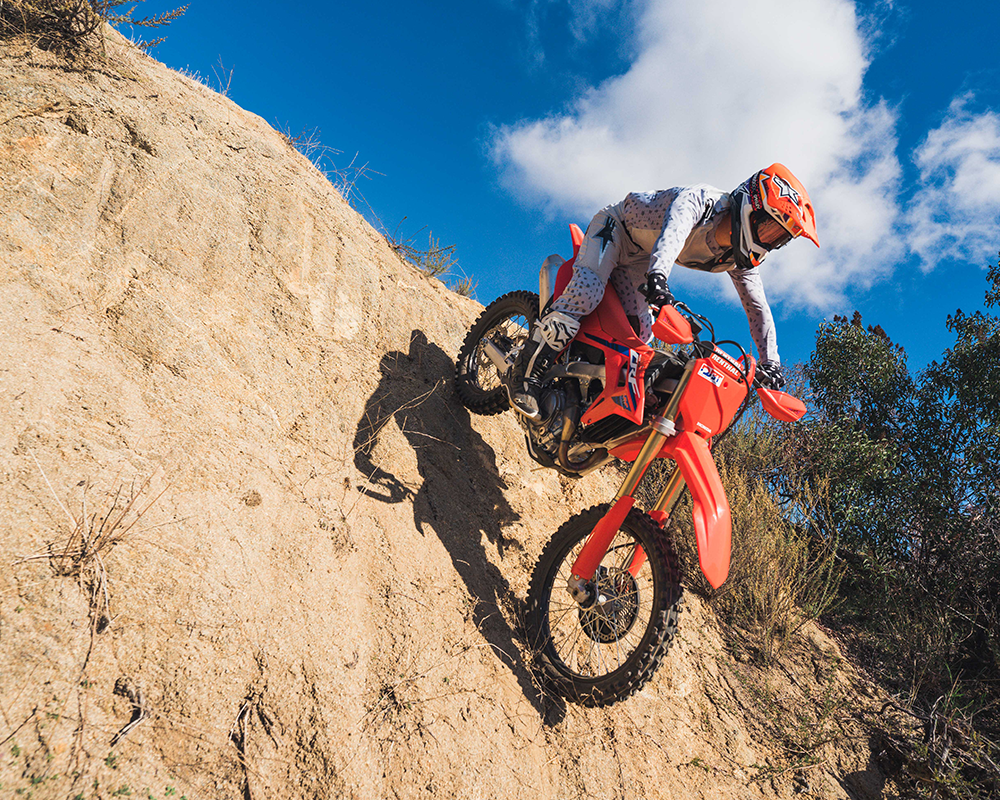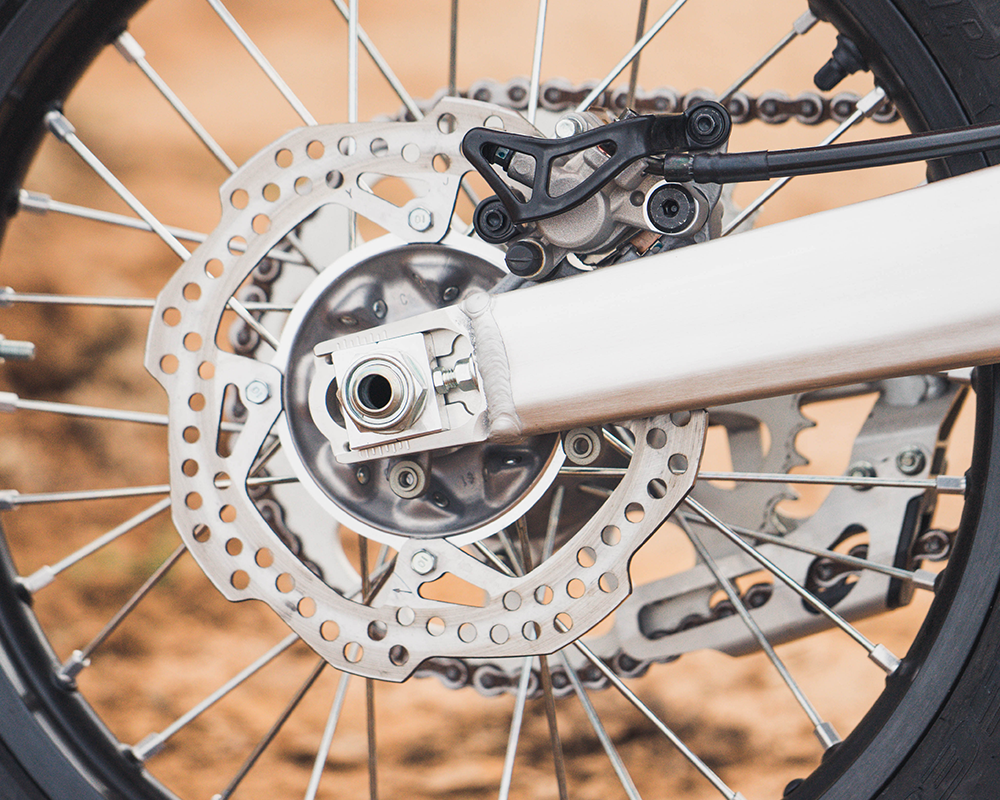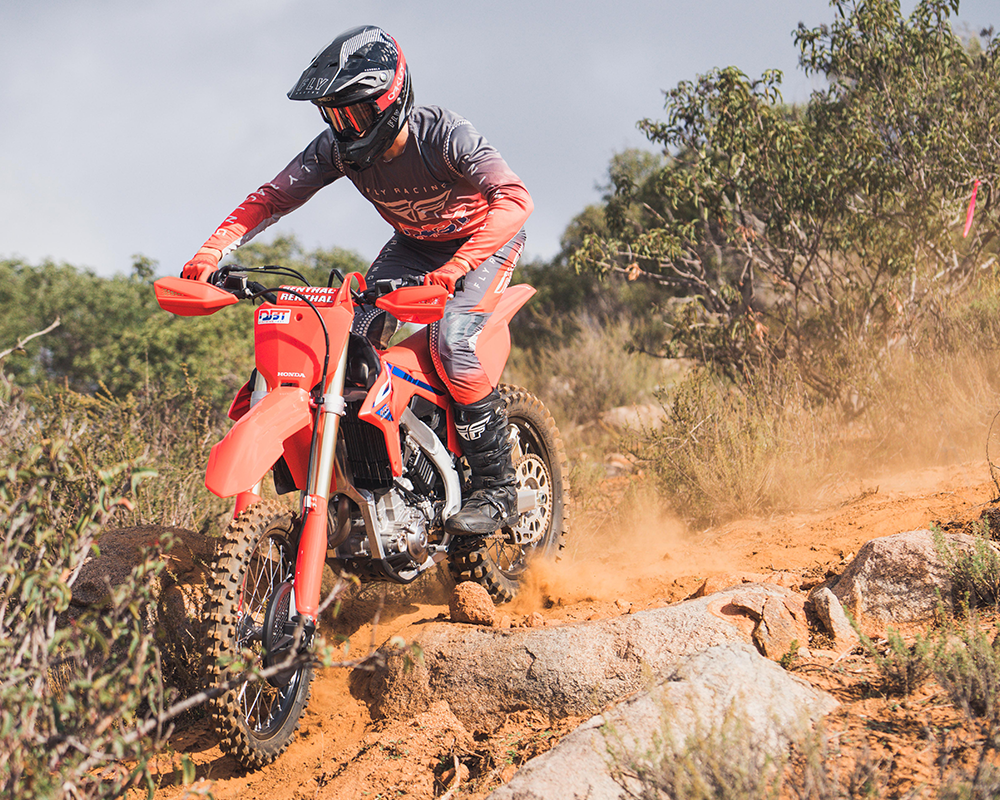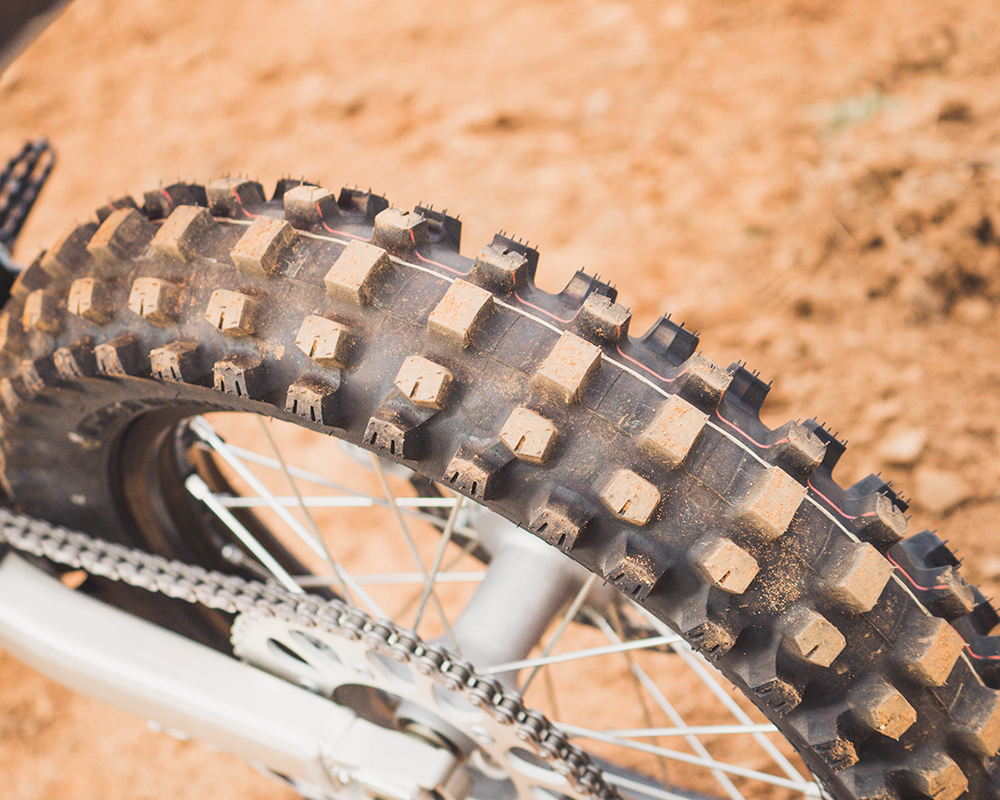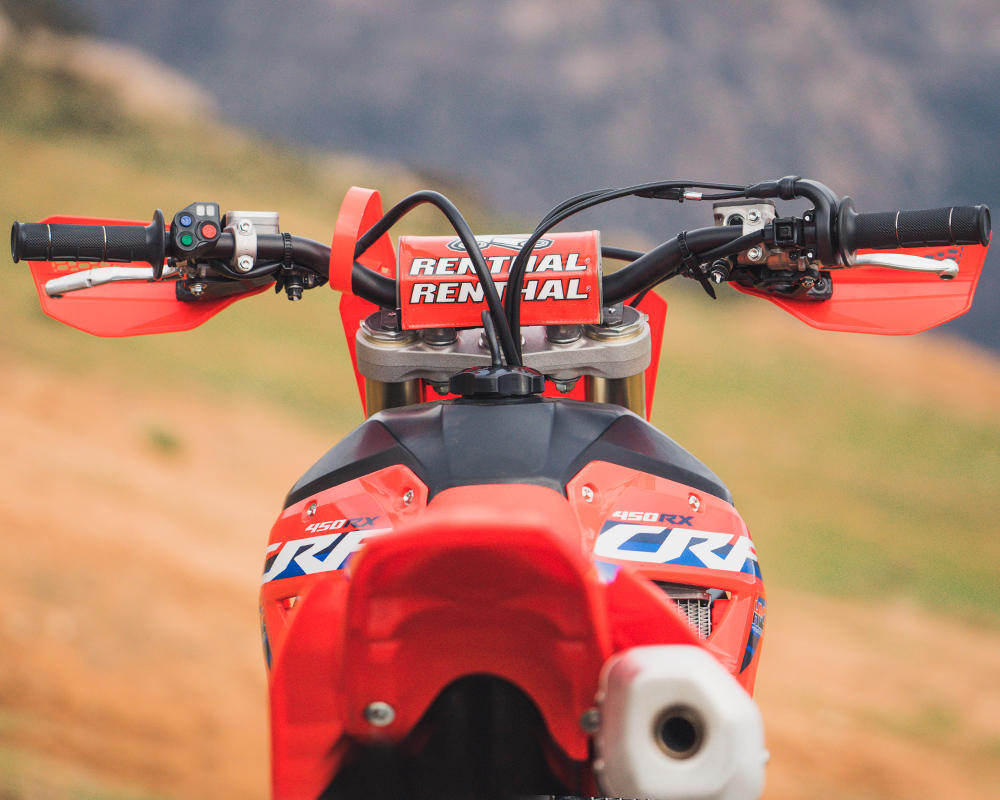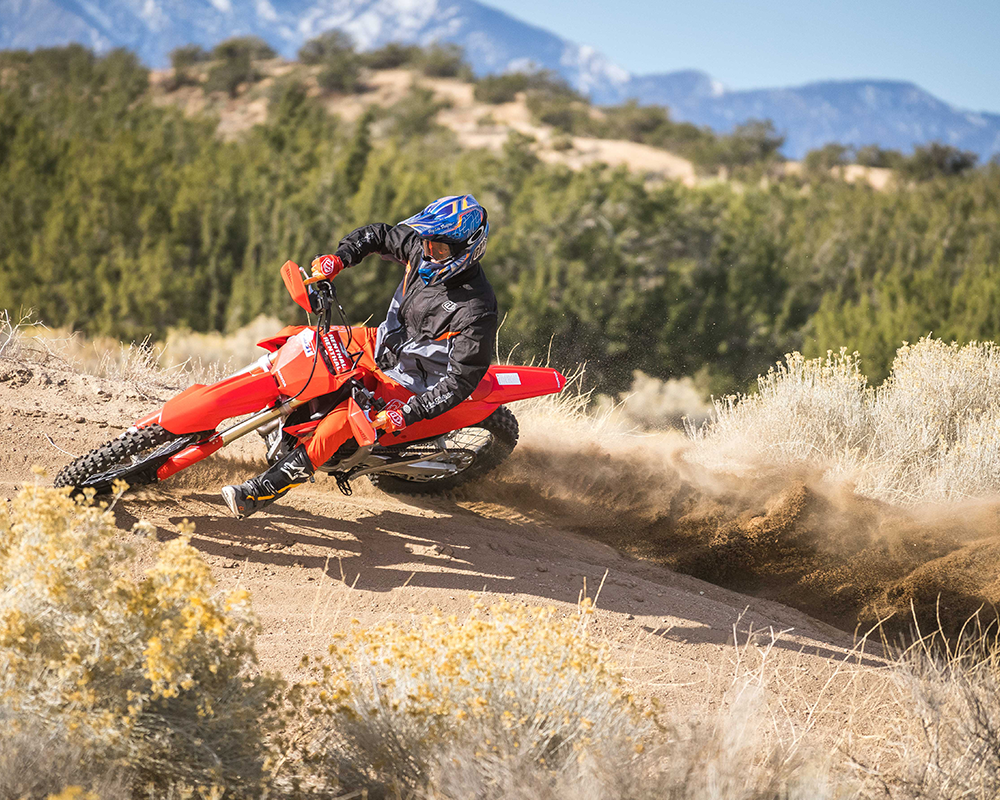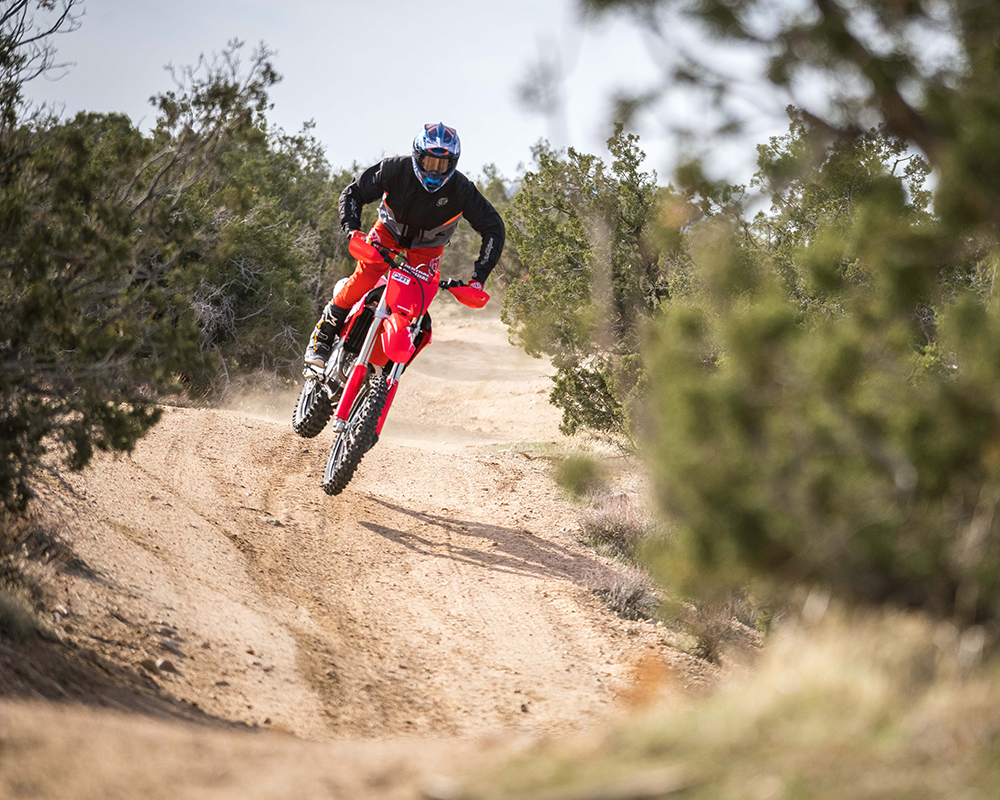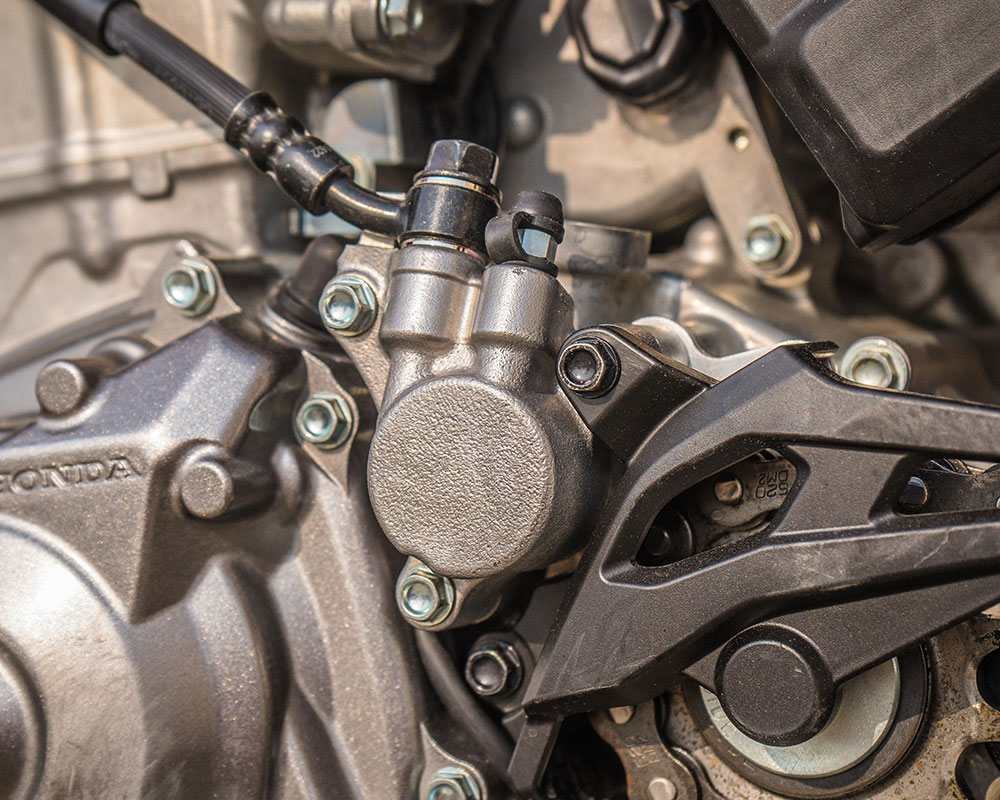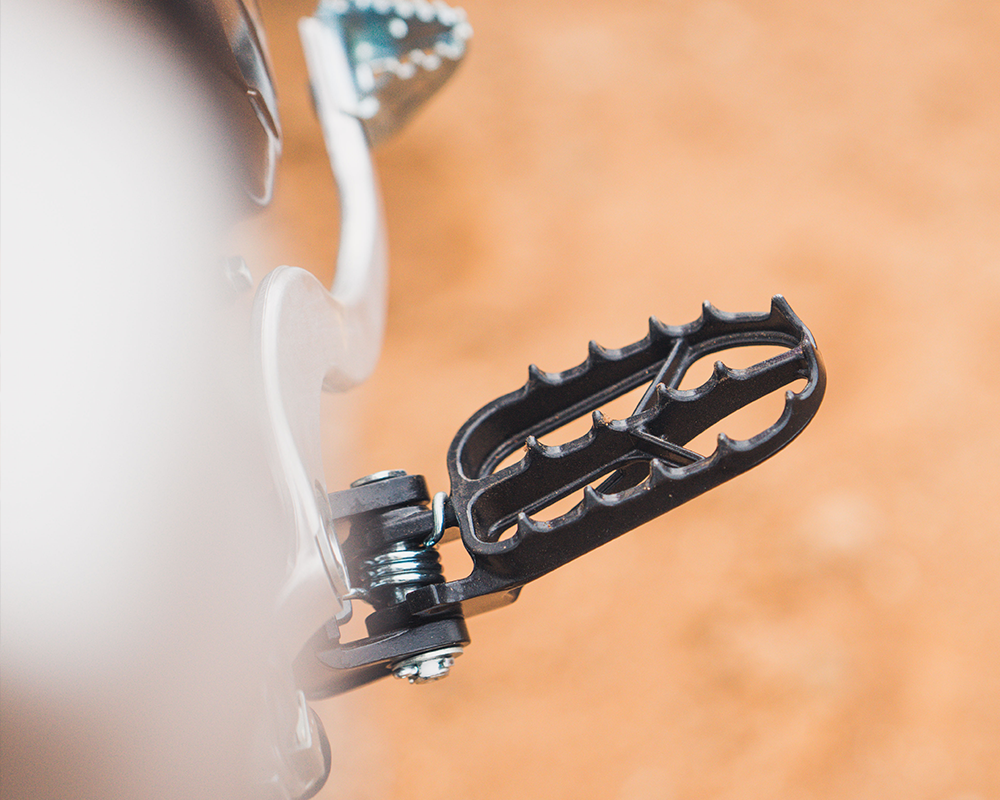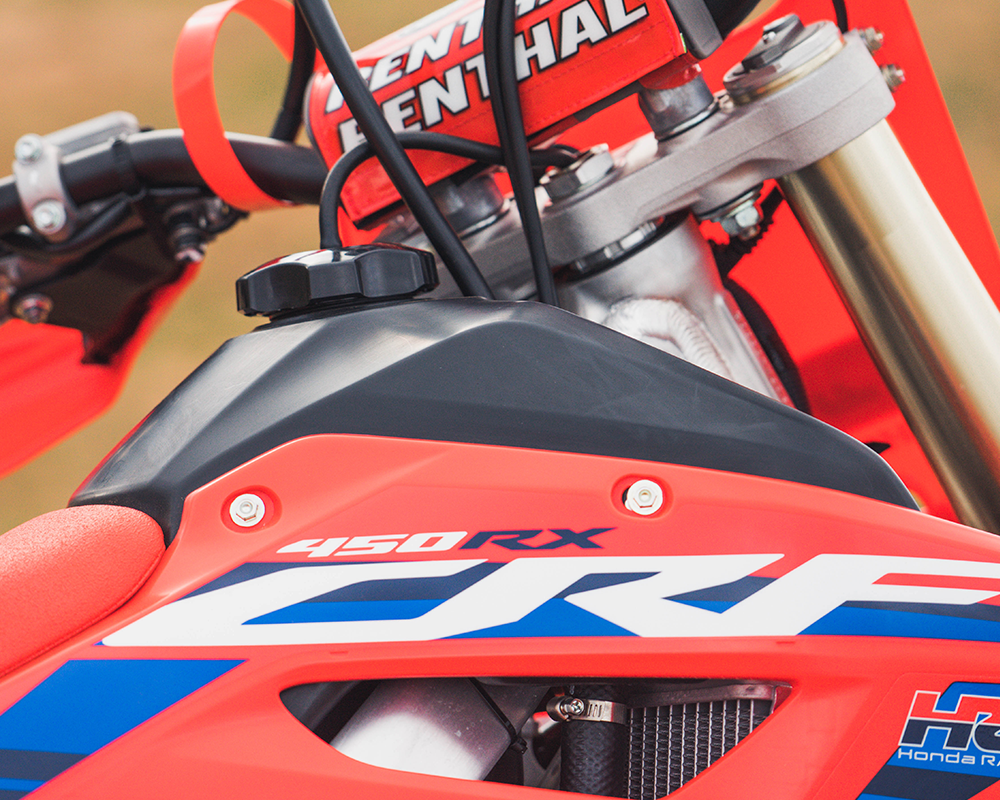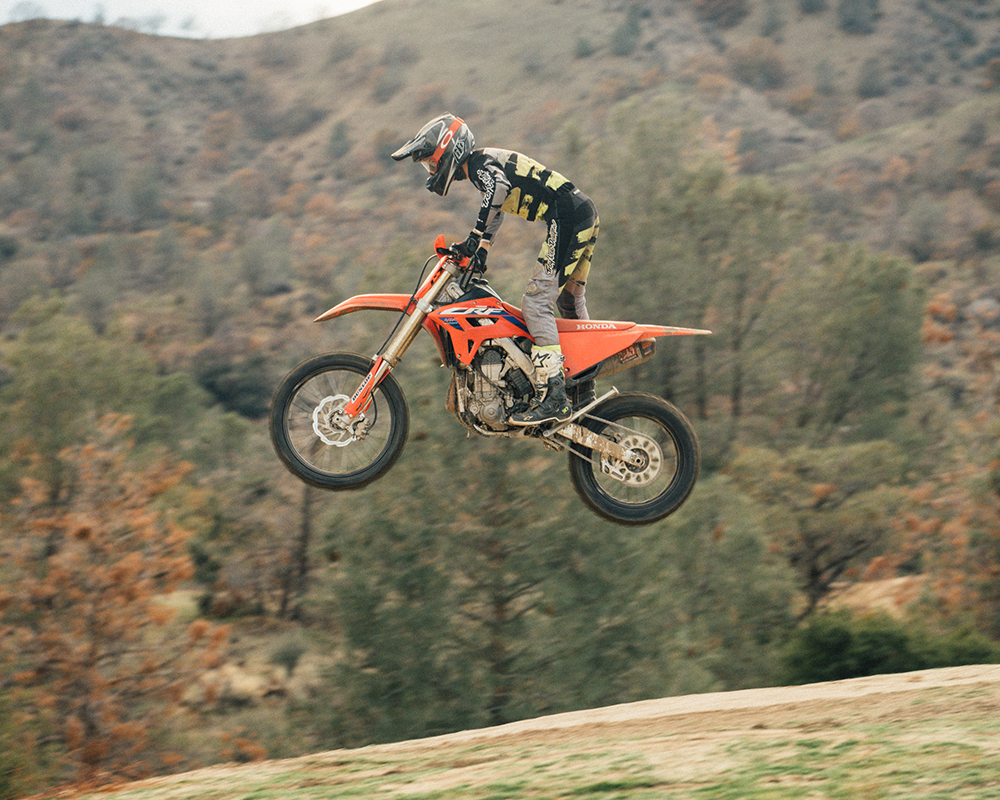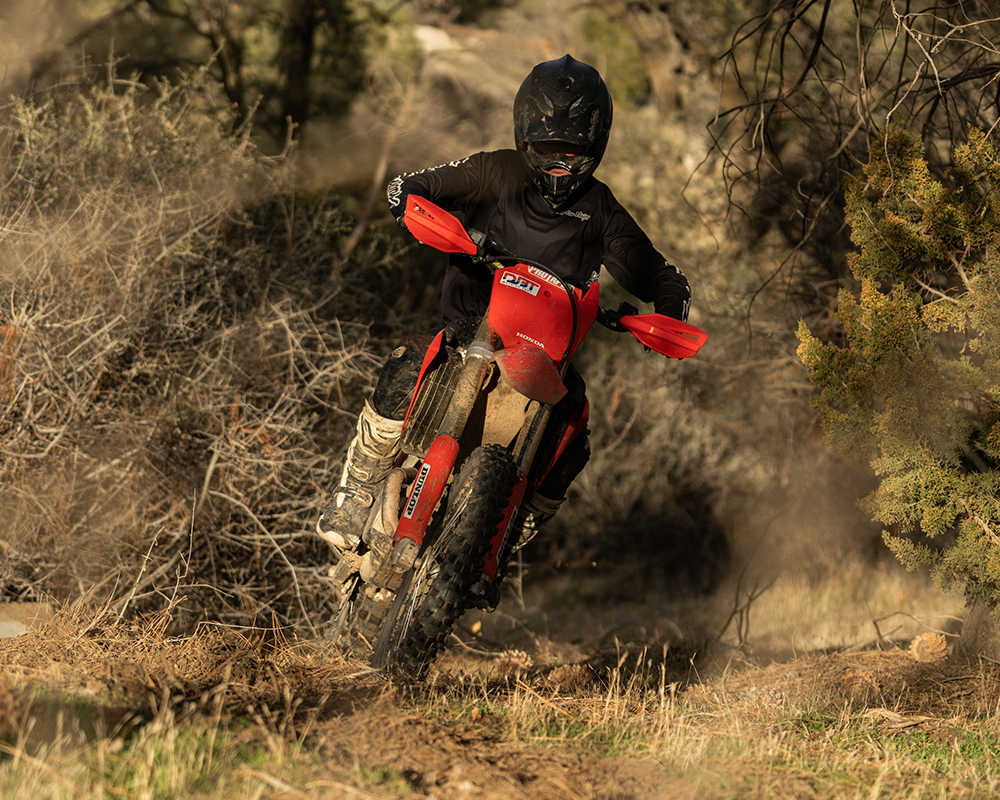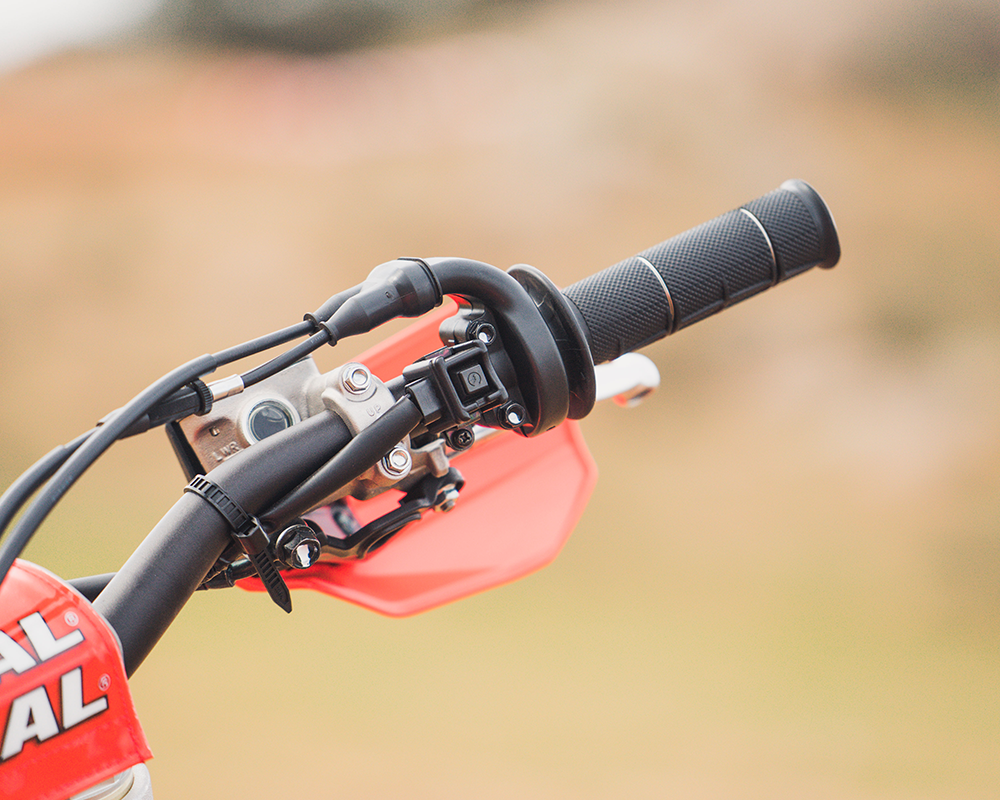2023 Honda CRF450RX
Small Changes Lead To Big Improvements
MSRP: $9,899
- Smooth and powerful motor.
- Fit and finish.
- Easier to work on than previous generation Honda’s.
- Light, nimble chassis feel.
- Very sensitive chassis.
- Mapping button is difficult to use on-the-fly.
- A semi-wide ratio or 6-speed transmission would have been a sweet addition.
Introduction
- Honda's big-bore competition off-road racer.
- Designed for NGPC/GNCC/WORCS.
In 2021 Honda released the new generation CRF450RX and the 2023 edition continues to refine the latest platform. Honda builds the RX for off-road, closed course competition and is targeted to events like NGPC, GNCC, and WORCS. It sits between the motocross oriented CRF450R and the more focused CRF450X. Although all three models share some similarities, the R and the RX feel like siblings where the X is a distant cousin.
Much like many of the competition focused off-road bikes in the industry, the RX looks like the motocross bike with an 18” rear wheel, different fuel tank, handguards, and a kick stand. If you dig a little deeper, you’ll find suspension tuned more towards off-road and different ignition maps. That’s not a long list of differences, which is why Honda’s off-road race bike feels right at home on a motocross track.
We’ve spent quite a bit of time on the new Honda and even raced some GP style events and Glen Helen’s 10-Hour endurance race. We started with a completely stock motorcycle and then began making some minor changes with a focus on modifications that we feel would be common amongst owners, nothing wild or unobtainable. As we progressed and fine-tuned the bike for our liking, we learned a lot about its strengths and weaknesses.
Changes
- A slew of motor updates to improve rideability.
- Chassis refinements aimed at offering more comfort.
- Off-road specific parts differentiate it from the MX model.
The CRF450RX’s technical updates include a narrower intake-port shape and longer intake funnel, revised cam profile and a smaller throttle body diameter designed to smoothen power delivery and increase torque, all while improving acceleration out of corners. The frame’s rigidity has been “optimized” by increasing material thickness in strategic locations and the use of steel engine mounts (replacing aluminum) helps improve front-end traction. Revised suspension settings complement the rigidity-optimized frame. To enhance strength (severely needed) and reduce noise, the muffler body is constructed from heat-treated aluminum, and a new inner-pipe design is used.
While similar to the CRF450R, the RX boasts a few key off-road oriented features. Those include dedicated ECU and suspension settings, an 18-inch rear wheel, an aluminum side stand, a large 2.1-gallon fuel tank, and hand guards.
Power
- This motor is fast.
- Light flywheel, quick revving engine.
- 5-speed transmission runs out of gear quicker than most.
- Changing maps on the fly is tough, but the maps make a difference.
The 450RX motor is among the best in the class. It pulls hard with an aggressive feel, but does it without sacrificing rideability. It’s not so aggressive that it wears you out or feels like it can’t hold traction which was a complaint of ours after riding an older generation bike a few years back. We think Honda found a good middle ground that should keep most riders happy with a more linear powerband than previous. The only place it may lack a bit is at the top end. It doesn’t have quite as much over-rev as others, and it gets there quick as it runs through the RPMs fairly fast. This is exaggerated in higher speed sections due to the motocross style close-ratio 5-speed transmission. One thing to note in the shifting department is the CRF shifts buttery smooth under a load and never faltered on us.
The Nissin hydraulic clutch is an item of interest for us. Of all the hydro clutches, and most bikes have them these days, the engagement feel is very quick. It has an on-off feel that can be especially difficult to use in more technical situations – which leads to the next thing. The motor has a lighter flywheel feel as well. It revs quick and easy, but can be prone to stalling as the speeds decrease. This is a common trait when taking a motocross bike off-road, and since it is so similar to the 450R, this is the case. For use in western style GP’s, where we feel this bike is ultimately designed for, that isn’t much of an issue. But as we took the bike out of that element and into true off-road terrains, it became more apparent. Some riders have found success installing a KX450 clutch master cylinder, or aftermarket pieces like ARC offers, for a better feel.
Overall, we like how the Honda runs and the options provided with the included ignition maps. All our test riders were able to find a setting that they liked in everything from tight technical trails to high speed sand washes and motocross tracks. The best way to describe the power delivery is that there is 1 to 1 throttle to real wheel connectivity no matter the map you are in. And with this 450, there is almost always more throttle waiting to be used.
One bigger change we went with on the 450RX, and this is more of a west-coast off-road focused change, is we went up on both ends with gearing from 13/50 to 14/52. This smoothened out the power throughout the curve and greatly helped the top end and over rev. With the gearing, we could run each gear a little longer and not find the need to shift as frequently. Additionally, we would often run out of gear quickly on faster courses, so the taller gearing helped in that area. Finally, the gearing changed helped smoothen the chassis feel as well. Similar to what we’ve felt on a Yamaha, the combination of the smoother power and the increased sprocket sizes “deaded” the hit on harsh hits, and made the bike feel as if it skims across acceleration chop rather than through it.
Suspension
- One of the stiffer setups on the showroom floor.
- Very balanced settings from front to back.
- Bike is senstive to clicker and chassis adjustments.
- Showa components are high quality.
Our riders liked the forks and shock in stock form, although we did need to spend more time than expected making adjustments. We experimented with fork height on the front, sag in the rear and clickers for both to find the balance we wanted. We came to realize that small changes have a dramatic effect on the RX so we needed to be mindful and make one adjustment at a time. In general, the suspension is very balanced and in comparison to the other 450cc off-road race bikes on the market, it is also one of the stiffest. This made us happy in the Western off-road conditions where motocross style valving and setups are more common than not for off-road racing. On the trail, the bike is better than the past editions, but it is quite stiff. Still, it is not as harsh as before, giving the rider a little less feedback without sacrificing precision.
While the stock suspension was good, we felt this was an area we wanted to focus on. We worked with Todd at TCS Powersports as his company is keenly focused on the type of events this bike is designed for and Todd, himself is a regular competitor in the NGPC and WORCS series’. We were looking for a little better balance and a little more hold up in the front to counteract some of the stinkbug feeling some of our riders were noticing. We felt that increased spring rates might be in order to keep the bike a little higher in the stroke. This was not only to accommodate some of our more portly test riders as even our lighter guys felt it was a positive change. We’ll dive into more of this in a separate article focusing on the bike’s modifications and why we went the route we did.
In stock trim, or near stock trim, we settled on running the forks flush in the clamps for a more stable chassis that isn’t so aggressive on the front end. In the end, we felt the bike still turned very well but we gained a lot of stability, and in some cases, the bike even turned better as we’d struggle with over steer having the clamps in their stock position at +5mm. Additionally, we ran sag between 105-108mm depending on the rider. A nice change we did make is shortening the shock shaft a couple millimeters, or installing a longer link arm which gives the same effect. This got rid of the stink bug feel that the Honda brings with a taller feeling rear end in stock trim.
Chassis - Handling
- Ergonomics are widely accepted by all of our riders.
- Nimble chassis that offers precision and feel to the rider.
- Sensitive to changes in terrain/conditions as well as setup.
Honda is known for neutral ergonomics and the new CRF450RX is no exception. Controls are right where they should be and for the most part just about anyone can jump on and immediately feel comfortable. The rider triangle is in spec and riders of all sizes feel it is one of the better cockpits out there. The most notable exception is the seat. It’s the one thing most of our testers disliked. It’s thin and once it breaks down a bit, the hard base becomes very apparent. Luckily a call to Guts Racing solved the problem when they sent us a new foam and cover that holds up much better and is a joy to ride with. While we were at it, we went with a 30mm taller foam to accommodate our older riders who are weak in the knees - the taller seat flattens the curve, making the transition from sitting to standing and back down much easier.
One thing we also felt helped is lowering the footpegs on this chassis. For riders of average height even, the pegs felt a tad tall and lowering them with Fastway’s EVO Footpegs really brought the cockpit around to be very well liked.
As mentioned, the RX shares a lot with the motocross model and that can be good and bad for an off-road bike. It’s a rigid chassis which provides the precise handling you’d expect from a track bike, but when conditions are less optimal, that rigidity can mean a lot less comfort and control. When traction is at a premium and the ground is hard, we feel this bike suffers more than others. However, when you do have traction and the ground is soft, this bike really handles well and is tough to beat.
The 450RX platform feels incredibly light and nimble thanks to its chassis and lively engine character that work hand in hand. Very few bikes are as easy to maneuver with such little effort. In mountain singletrack, the bike feels 10-15 lbs lighter than most of the other bikes in its class. However, this agility comes at a bit of a cost as speeds increase. The CRF lacks stability in the high speed chop, and you feel more of what you’re hitting.
This Honda chassis is drastically different from the other major OEM’s in that you really feel the ground underneath you and it likes to be precise. If it gets loose, it’ll react and want to snap back in line. Likewise, the front wheel feels very close to the rider and you feel as if you’re riding on top of it. Again, none of this is necessarily good or bad - it’s just different and a feeling some riders want and others don’t.
We also believe that the stiff chassis contributes to the overall sensitivity of the chassis. This bike has a smaller “happy place” window than most in that it has a higher potential to handle well, but also has the ability to not handle quite as well if setup is off or conditions change.
Showing how sensitive the chassis is, rather simple things like fork height can really make or break the handling character. We experienced this first hand at the 10 Hours of Glen Helen where we started the race with the forks at +5mm, but halfway through, we dropped them to flush and instantly the CRF was a whole new bike and for the better –a much more dramatic (and positive) effect than we would typically experience from a change like this. In general, we’ve come to like the forks flush for all but tight singletrack riding.
Likewise, we made a few seemingly minor changes not even intended to affect the chassis much but had a drastic effect on the track and trail. First, we swapped out the stiff Dunlop AT81F front tire for a Dunlop MX33F – a tire with a softer carcass and sidewall feel that not only improved traction for us, but also reduced harshness felt through the front end. Another change was switching from the stock Renthal Fatbar to a Pro Taper EVO handlebar. Like the tire, the different handlebar was less rigid and reduced feedback to the hands/wrists. We feel we could take this another step further and go to some Fasst Co Flexx Handlebars, but just the straight swap from Renthal to Pro Taper handlebars had a pronounced effect on the handling.
Chassis torque is very important and sensitive on the CRF450RX and we have a detailed article going over what changes can be made and how they affect the bike, both positive and negative, which you can read HERE.
Conclusion
- Race inspired, aggressive bike.
- More motocross than true off-road, but it has its place.
- Very capable with a lot of potential.
The 2023 Honda CRF450RX is a solid contender in the competition off-road class. It’s not the most versatile of the group, but many riders will appreciate the strong motor and motocross inspired chassis. The bike performed well in our 450 Off-Road Shootout with most riders giving it positive reviews and ranking it highly. The precise chassis and quick handling will appeal to some and not as much to others. Overall, we feel it’s a solid option for a lot of riders and one that can be fine tuned to your liking. We’re going to continue to spend time on the bike and have plans for more racing and a few new parts to evaluate to see if we can address some of the concerns we’ve stated above. So as is often the case, we’ll keep learning more about the bike and of course, that will all be shared here.
The question is, did the refinements Honda implemented improve the CRF450RX? For the masses, we believe so. The engine is easier to ride, the chassis is easier to tune to the conditions/rider, and is overall a more rider friendly motorcycle.
Recent Product Tests
Leave a Reply
